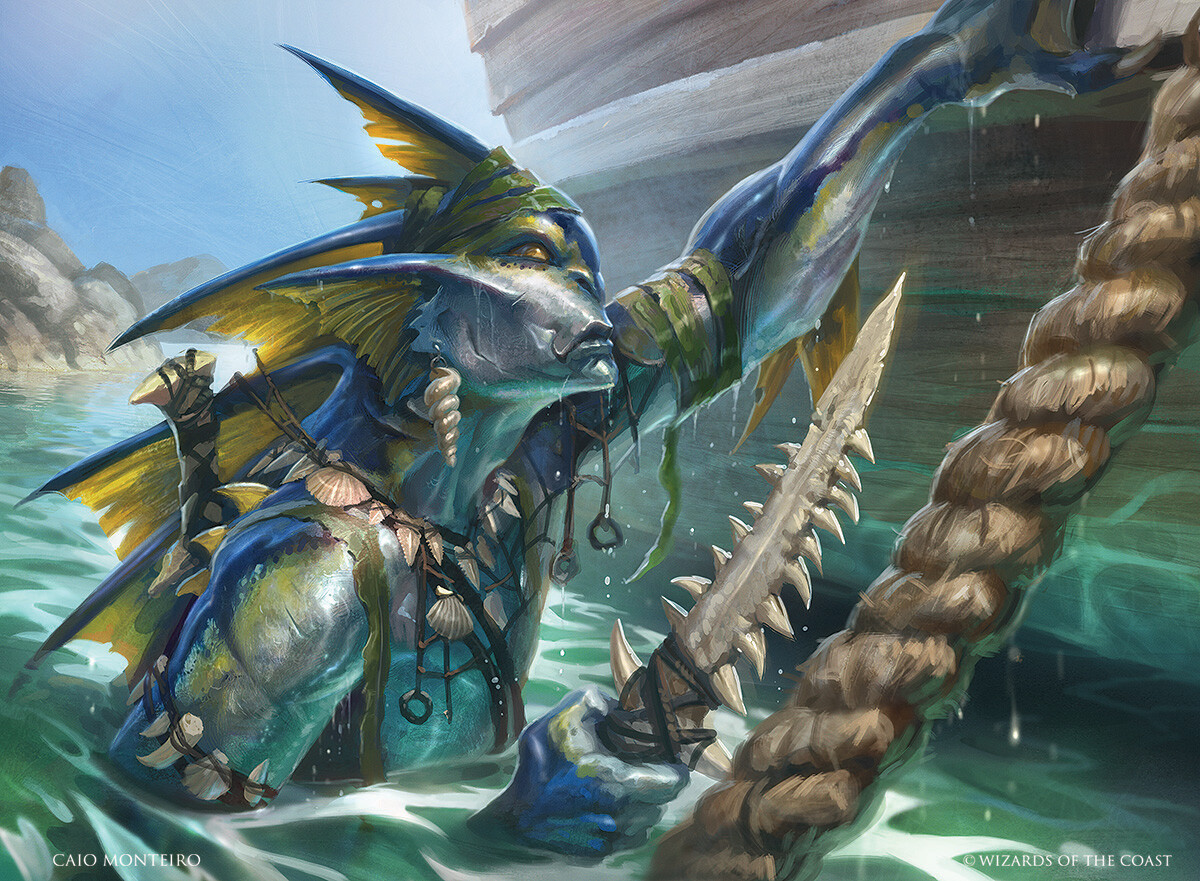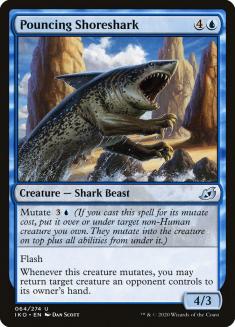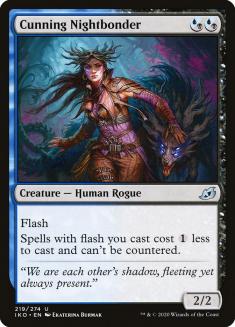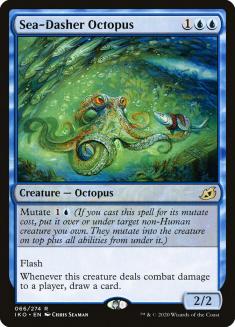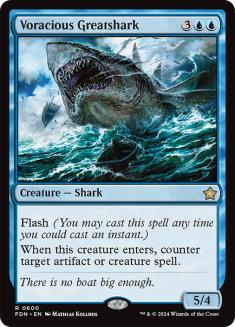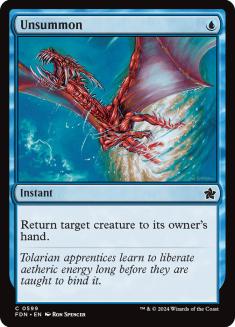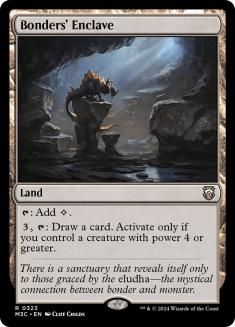With Ikoria: Lair of Behemonths just around the corner, everyone’s looking at all the flashy splashy rares that completely dominate a game. That’s not how I roll. Outside of looking for engines to build around, I personally like to examine the commons and uncommons to figure out which will have the biggest impact. In this set alone, there are four or five of those build-around-me engines, and none of them are really giving me Wilderness Reclamation or Fires of Invention vibes. With that said, a few creatures from the new set are giving me the vapors.
Ikoria: Lair of Behemoths Standard is likely to be full of splashy, unique, and powerful effects that are hard to beat…if they resolve. Since there are quite a few new toys for Mono-Blue Aggro, it might be time to break out the small guns. Sometimes it takes surgical precision to break a format.
Let’s talk about the new tools and what I want them to accomplish.
This is a strange one I haven’t seen many people talk about, but I do like the idea of having a cheap-ish flash creature that can do some bouncing. With enough creatures, you need them to start acting like spells. Thanks to mutate, many of the creatures in our deck will start acting like spells, because they all have some cool effect when you do trigger mutate.
This is not one I want to play too many of, but it is certainly an interesting tool to discuss. Mutate is something we haven’t seen before, and I’m thinking combining flash and mutate might end up being pretty sick. Also, apparently cards like Unsummon work incredibly well with mutate! Who knew?
Pouncing Shoreshark is not going to change the world. It might not even make the cut at the end of things, but this next card will make you reevaluate all creatures with flash.
This is the card I’ve wanted to write an article about for the last week or so, but preview season usually requires us content creators to pick a powerful card and try to build around it. Role-players that go into existing decks aren’t exactly popular to talk about. Even now, I don’t recall a single person talking about this card on Twitter, yet it’s my pick for one of the most impactful cards in the entire set. Why?
Making your stuff cheaper is a big deal. Yes, it only works with creatures that have flash, but you can play a lot of creatures with flash in Standard at the moment. In Mono-Blue alone, you have access to around a dozen choices, and about six of those are quite good. If you want to delve into another color, those options increase dramatically.
What I’m really interested in is seeing how Cunning Nightbonder’s cost reduction works with mutate creatures. Having a variable casting cost is already cool as hell, but what about when two different iterations of the card cost one less, giving you even more options? Half the point of mutate is that the card is useful or cheaper because you’re not getting that additional body. In this instance, the creature is acting more as an Aura than a creature itself. Regardless, making those things cost less is a big deal.
Cost reduction on a card also opens up potential for plays that weren’t possible on specific points of mana before. That can drastically change the entire shape of a game. For example, when your opponent passes with four mana up, you can guess around five or six permutations of cards at their disposal and hopefully find the best way to navigate against the more likely or more disastrous combinations. When you throw Cunning Nightbonder into the mix, the outcome becomes nearly impossible to predict, making your turns better and your opponent’s turns worse.
Cunning Nightbonder works incredibly well with Sea-Dasher Octopus, thanks to the cheap original body and cheaper mutate. Since Sea-Dasher Octopus will be the star of the show, having another creature built specifically to make it better could be desirable in the right shell.
Emma Handy wrote about this card last week and really hit the nail on the head. This card really does it all, and it gives us something we’ve been missing for the last few months. Curious Obsession was a huge part of the original Mono-Blue Aggro deck. That constant source of card advantage made for some quick work of opponents that couldn’t kill the creature that was enchanted.
Sea-Dasher Octopus is so much more than that. Aside from being a two-mana Curious Obsession, it’s also its own creature. A flash-style deck, more traditionally called “Draw-Go” in the past, has wanted some way to draw extra cards. At times, people have played Ophidian or Thieving Magpie. We aren’t doing that exactly, but we can follow those guidelines and understand that a creature like Sea-Dasher Octopus that draws cards when it connects is powerful in a strategy that wants to counter every spell the opponent casts.
But it has flash, so it’s even better than that. On the third turn, your opponent needs to be attacking you already or else you’re likely to walk all over them. If they aren’t attacking you, feel free to flash in the Sea-Dasher Octopus and get to work. If you’re able to stick an early creature with evasion, suit it up with a Sea-Dasher Octopus and get to work. The fact that you can deploy this when the opponent’s shields are down is absurd.
I want to stress to you that this card is so much better than anything we’ve seen before it. Ninja of the Deep Hours sees regular play in a lot of older formats and it is my belief that this card is better. Curious Obsession was a major player in this deck last season and it is my belief that Sea-Dasher Octopus is better than that too.
It’s hungry and it’s coming for dinner. Voracious Greatshark is a little odd, functioning like a slightly more expensive Frilled Mystic. At times, Frilled Mystic is pretty mediocre because it’s so expensive and the body is small. Medium-sized creatures are also hard to race because your creatures are pretty small and don’t really block well. Voracious Greatshark throws all of that completely out the window.
If this thing ever eats a creature, the game should be over. The body is huge, and the effect is backbreaking in the right spot because the body is so huge. I can’t even imagine the feeling of countering your oppponent’s creature while you’re already ahead on the battlefield.
Mono-Blue never had that “it” factor like Simic. You didn’t have an “uh-oh” moment when you cast any of your creatures because the opponent could just kill or counter or maybe even race your threat because it was so incredibly tiny. Well, now we’ve got a little beefcake on our side.
With all that in mind, let’s take a first look at the new Mono-Blue Flash in Standard.
Creatures (23)
- 4 Spectral Sailor
- 4 Brineborn Cutthroat
- 4 Brazen Borrower
- 3 Voracious Greatshark
- 4 Sea-Dasher Octopus
- 4 Cunning Nightbonder
Lands (3)
Spells (34)

We’ve seen a few iterations of this style of deck over the last year and change. They’re usually weak to aggro decks, and have trouble with stuff like Cat/Oven. However, I have a feeling that’s slowly changing. With the release of Ikoria, more people will be going large. These engine cards like Whirlwind of Thought and Song of Creation are pushing people to go more midrange, which in turn slows the format down and allows counterspells to creep their way back into the limelight.
With that said, if the wrong half of the format shows up in the first few weeks, you might have a little trouble handling the decks that are lower to the ground. Without proper removal or creatures with reasonable bodies to block or trade in combat, things can go south in a hurry. It’s not like Spectral Sailor is surviving a block.
The play I’m looking forward to the most is bouncing my opponent’s creature and having them walk it right into Voracious Greatshark. Honestly, the idea of chomping on some of your opponent’s two- or three-drop creatures after you bounce them is pretty sick. Bounce spells are usually mediocre because they’re negative card economy, but things change when your bounce spell comes with a Vendilion Clique body or your counterspell on the way back down is attached to a giant Shark.
Sea-Dasher Octopus can change everything. Not only does it come down on an empty battlefield and start attacking, it can function like Curious Obsession if your opponent doesn’t have a lot of removal. Even if they do have removal, if you’re able to connect and draw one card with Sea-Dasher Octopus, you’re not technically losing much because it’s replacing itself. The problem is that Standard isn’t really about drawing one card at a time. Card economy starts to matter less when everything you both cast says “draw a card.”
But decks like Mono-Blue Flash function well off a low card count, actively choosing to sacrifice card economy in favor of battlefield or mana advantage. It’s the nature of the beast, using all pieces to get the job done. Losing Curious Obsession certainly made winning with the archetype much harder, but now the question is whether or not Sea-Dasher Octopus can fill that gap. If it can, this deck might be poised to take over the format. If Sea-Dasher Octopus ends up being a bust, well, you’ll probably hear as much about this deck as my Primal Amulet deck.
I’m excited to see more of actual Unsummon in Standard, as it feels like a tool ripe for sick interactions. With mutate being a key ability in the archetype, using a one-mana spell to save your creature and your Sea-Dasher Octopus is pretty absurd. On top of that, having multiple spells that bounce creatures along with some anti-creature counterspells runs pretty smoothly.
Unsummon has a lot of value in decks like this because saving your own creature from removal is occasionally just as good as, if not better than, bouncing your opponent’s stuff. If your opponent has a control deck with a bunch of removal, Unsummon can be one of the best protection spells imaginable. If you play against a midrange deck with a bunch of mid-sized creatures, your bounce spells become outrageous, acting as dual-sized removal/protection.
Against aggressive strategies is where these bounce effects start to be miserably bad. When your opponent is spending little mana on their creature, bounce effects just aren’t useful. They will occasionally have one or two creatures worth bouncing in some spot, including Anax, Hardened in the Forge and Runaway Steam-Kin, but the plethora of one-drops is the real problem. They get under you and everything starts to fall apart! They kill your Brineborn Cutthroat and suddenly all your defense evaporates.
Unsummon with Spectral Sailor is also a great way to generate additional counters on Brineborn Cutthroat, so don’t sleep on that interaction to squeeze in extra points of damage.
I’m unsure if this one will end up staying in the deck, but I felt like it wasn’t too terribly difficult to get a Brineborn Cutthroat to four power or just resolve a Voracious Greatshark. This land enters the battlefield untapped and has no real downside otherwise. It’s also something we could definitely look into combining with Mu Yanling, Sky Dancer if we end up playing it maindeck. The planeswalker is certainly powerful and just needs some help to take over the game.
Bonders’ Enclave feels like it fits perfectly here, as you can choose between deploying threats at instant speed or drawing cards. If you don’t have a creature big enough to draw cards, it’s not like the singleton Bonders’ Enclave is going to break you too often. I can see it being somewhat troublesome with the Castle Vantress, but that’s a sacrifice I’m willing to make for now, especially when all I’m really doing is testing things out.
Going Small in a Big World
All the new cards in this deck will likely make it play differently from how any of us are used to. Sea-Dasher Octopus is such a strange and wonderful card that I’m honestly not sure what to do with it. It’s versatile, functioning as both threat and augmentation. I can’t wait to see how it goes.
With the rest of Standard going outrageously big, throwing haymaker after haymaker, it’s only fair that a small deck swoops in and cleans house. Is this the deck that can actually do it, and is Sea-Dasher Octopus the card that puts us over the top?
It’s possible that I’m framing this deck in entirely the wrong fashion. For example, Faerie Miscreant might actually be a great threat to cast on the first turn to give you a body for Sea-Dasher Octopus. It’s good enough for Pauper and seems to work nicely with Ninja of the Deep Hours. Maybe it’ll be the same here.
If that’s the case, the deck will likely need to be built differently. This iteration is modeled after the Simic Flash decks we’ve seen in recent times, but maybe we should build it more like the Mono-Blue Aggro decks of old. An emphasis on Sea-Dasher Octopus is great if the opponent can’t kill your creature or you get to draw more than one card out of it! Building completely around it seems great to me, though we no longer have the absurd Plan B of Tempest Djinn.
Initial builds of decks like this are often hard to put together in the right way because they play so much differently from what we’re used to. The big engine cards like Fires of Invention or Wilderness Reclamation give you a lot of free wins because the cards are powerful enough and generate enough resources that casting basically anything that uses a lot of mana is likely to win you the game. But the difference between building your deck with eight one-drop creatures versus four can alter how the entire rest of your deck functions. You’re walking a tightrope, but all it takes is getting close and trying out some different looks before you strike gold.
I’m very much looking forward to trying this out, but my heart is yearning for Sea-Dasher Octopus in older formats. How will it look in a Delver shell? Will it help make Disrupting Shoal a real card in Modern? My guess is yes, and I’ll be on the front lines trying it out.

